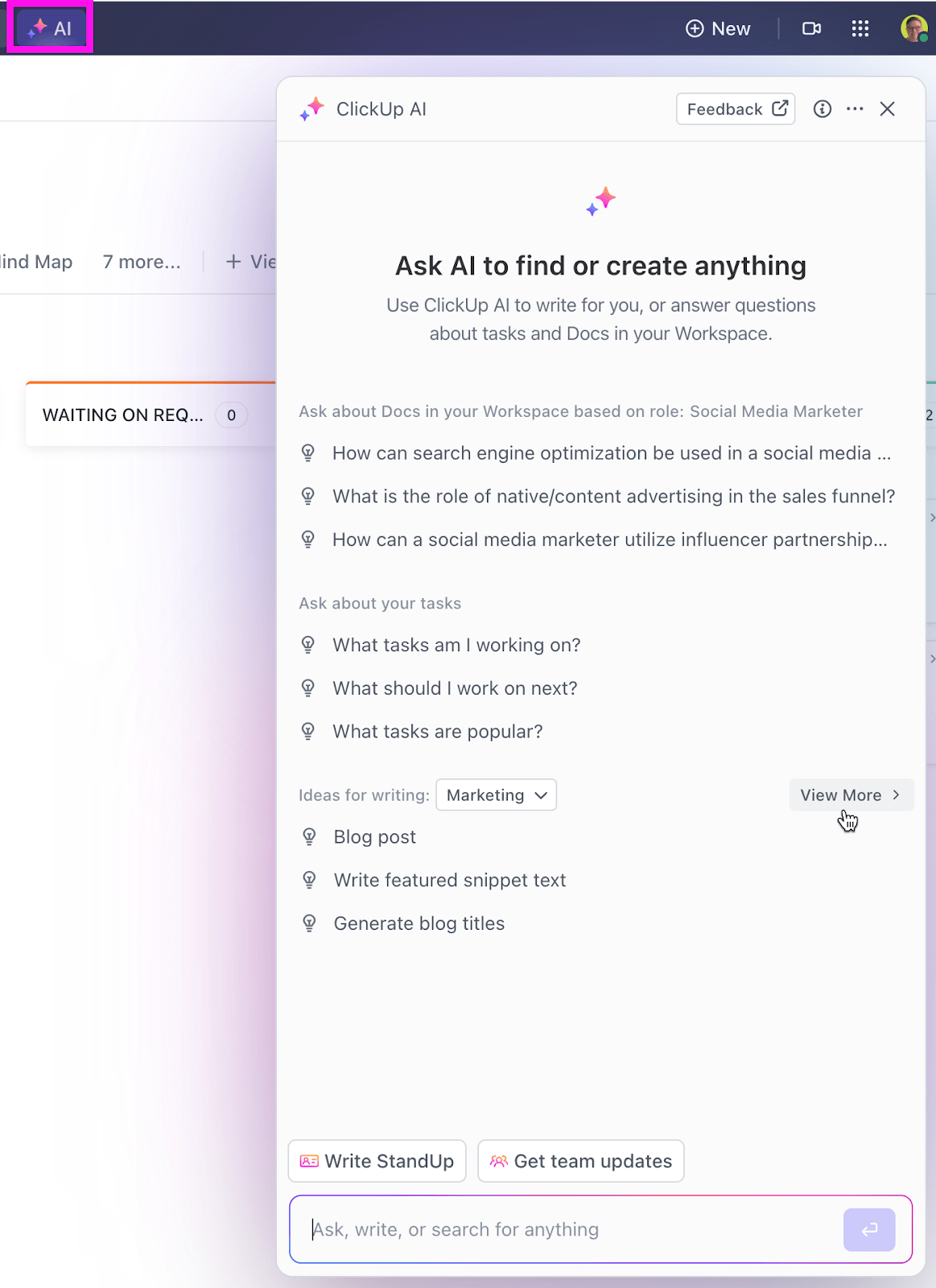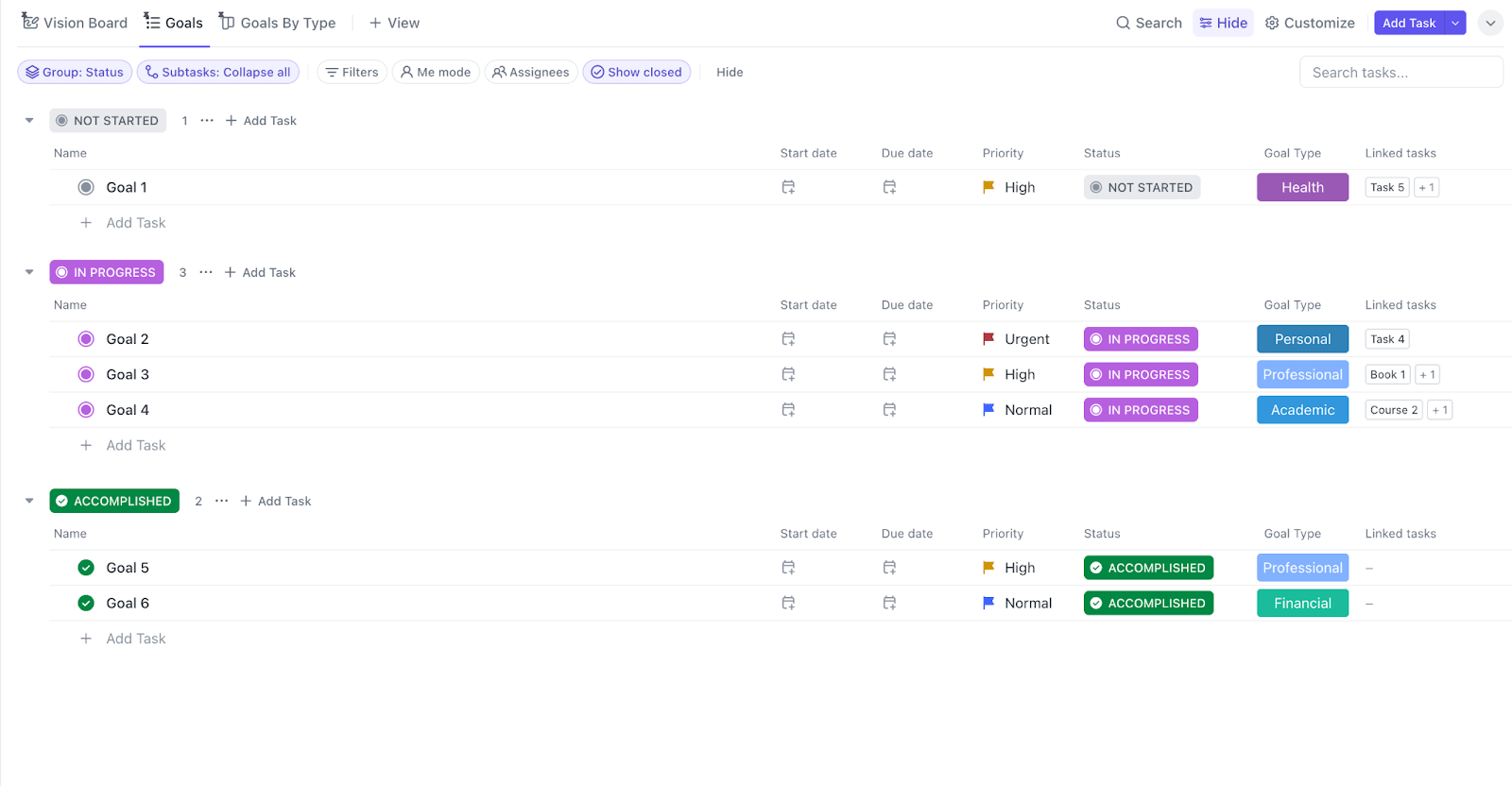

As a seasoned manager, I’ve seen firsthand how the relentless pace of work can drain employees and cause their productivity to drop. The constant barrage of deadlines, meetings, and emails can overwhelm even the most organized professionals.
And, let’s not ignore the declining productivity growth trend highlighted by recent data from the Organization for Economic Cooperation and Development (OECD).
In 2022, multifactor productivity growth (MFP) took a hit in ten out of twenty-four OECD countries. The United States saw a particularly sharp decline, with MFP plummeting from 1.7% in 2021 to a negative 1.6% in 2022.
These numbers indicate a need for effective productivity strategies to navigate the demanding work environment and help drive productivity metrics. And that’s where productivity hacks come in. Simple, often unconventional methods can revolutionize your workday, allowing you to focus on high-impact tasks and achieve more.
Let’s see how.
- Common Productivity Hacks
- Hack 1: Practice time blocking
- Hack 2: Try the Pomodoro Technique
- Hack 3: Get minor tasks out of the way using the two-minute rule
- Hack 4: Prioritize tasks using the Eisenhower Matrix
- Hack 5: Identify critical tasks using the 80/20 rule (Pareto Principle)
- Hack 6: Eat that frog!
- Hack 7: Batch similar tasks—and get them all done together
- Hack 8: Take a shot at the 1-3-5 rule
- Hack 9: Use templates for repetitive tasks
- Hack 10: Delegate wisely
- Hack 11: Automate everything you can!
- Hack 12: Conduct time audits
- Hack 13: Transform your environment
- Hack 14: Adopt the Ivy Lee method
- Hack 15: Use a digital notepad for brain dumps
- Hack 16: Say ‘No’ more often
- Hack 17: Schedule breaks
- Hack 18: Set SMART goals
- Hack 19: Reflect and adjust
- Hack 20: Use reminders
- Digital Tools and Apps for Productivity
- Tips for Sustained Productivity
Common Productivity Hacks
Effective productivity hacks help overcome procrastination, improve focus, and solve time and project management issues from the ground up. Incorporating them into your daily routine will help you strategize and achieve your goals more effectively.
(And if you’re looking to implement these productivity hacks easily, try using a work management tool such as ClickUp that brings your tasks, conversations, and knowledge together and enhances them with AI.)
Here’s a breakdown of the best productivity hacks to boost efficiency:
Hack 1: Practice time blocking
Time blocking refers to dedicating specific blocks of time to specific tasks. Instead of multitasking—which can cost you as much as 40% of your productive time—you focus on one task during each block. So, you may end up scheduling deep work during the morning because that’s when you have the most energy, and calls or meetings in the afternoons when you’ve finished tackling the most critical tasks for the day.
ClickUp’s Calendar View can help you schedule these tasks into the desired blocks…
…and ClickUp’s Project Time Tracking lets you track how long each task takes.
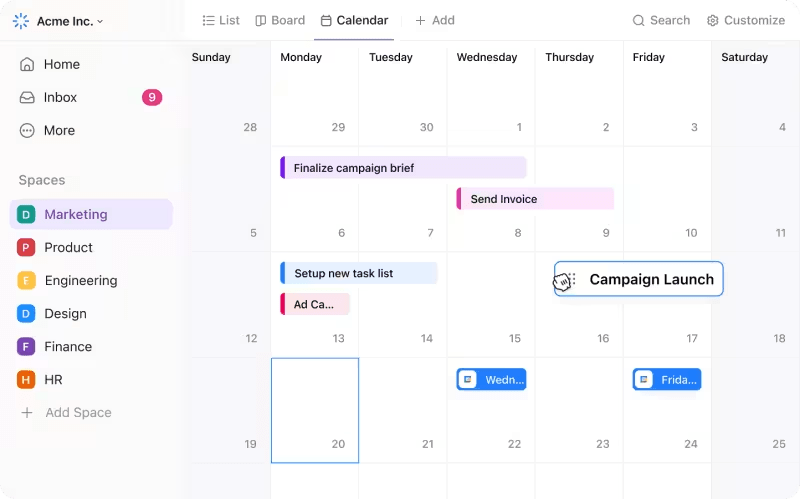
When managing a complex project with multiple tasks and deadlines, I use the Calendar View to map out each task and visually assign specific time blocks. This gives me a clear overview of my workload and helps me prioritize tasks effectively.
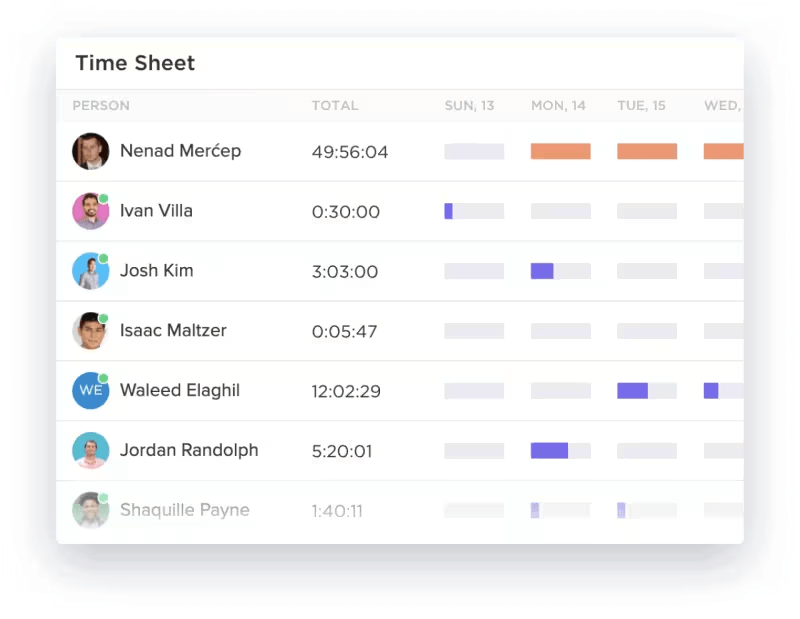
But the real trick is to combine it with Project Time Tracking. As I work on each task, I use ClickUp to track the time spent on it accurately. This data helps me identify time-consuming bottlenecks and adjust my future estimates.
Hack 2: Try the Pomodoro Technique
The Pomodoro Technique involves working in 25-minute short bursts, followed by five-minute breaks to recharge and avoid excessive cognitive load. This hack can help maintain focus and prevent burnout.
Here’s how I implement the Pomodoro Technique using ClickUp:
- Set the timer: I use ClickUp’s Time Tracking integration to set 25-minute work intervals and 5-minute breaks
- Focus on a single task: During each 25-minute Pomodoro, I concentrate on a specific task, such as drafting an email, analyzing data, or writing a blog post. You can also schedule longer Pomodoros of 30 or 45 minutes or combine two Pomodoros of 25 minutes each for more demanding tasks
- Create a focused environment: I minimize distractions by closing unnecessary tabs, turning off notifications, and finding a quiet workspace. White noise or focus music like binaural beats also help
- Short breaks: After each 25-minute interval, I take a 5-minute break to rest my mind. I might stretch, meditate, or simply step away from my desk
- Longer breaks: Every four Pomodoros, I reward myself with a longer break of 15-30 minutes
This structure helps me stay on track and make steady progress without feeling overwhelmed.
Also Read: 15 Best Pomodoro Timer Apps to Focus
Hack 3: Get minor tasks out of the way using the two-minute rule
The two-minute rule is a simple yet powerful technique that keeps me organized and efficient. The crux? If you can finish a task in two minutes or less, do it immediately.
For instance, if I receive an email requesting one simple piece of information, I don’t let it sit in my inbox. I apply the two-minute rule and respond immediately. This small action prevents the task from lingering and becoming a larger, time-consuming chore.
To facilitate this, I rely on ClickUp’s Reminders feature. I set reminders for quick tasks, such as sending a thank-you note or following up on a lead. This ensures that I address these small tasks promptly, freeing up mental space for more complex projects.

👀 Did You Know?
The Zeigarnik Effect is a psychological principle where people tend to remember incomplete or interrupted tasks more vividly than completed ones. This effect can lead to persistent mental tension or preoccupation with unfinished tasks, driving a desire to complete them to achieve closure. It’s often linked to productivity strategies, as breaking large tasks into smaller, unfinished steps can help maintain focus and motivation.
Hack 4: Prioritize tasks using the Eisenhower Matrix
The Eisenhower Matrix helps prioritize tasks based on urgency and importance. You can divide tasks into four categories: ‘urgent and important,’ ‘important but not urgent,’ ‘urgent but not important,’ and ‘neither.’ This helps decide which tasks to tackle first and which you can push to a later time, delegate, or even delete.
Use ClickUp’s Task Views and the ClickUp Eisenhower Matrix Template to organize your tasks according to these categories. This will ensure you always tackle the most critical items first and avoid wasted time.
Hack 5: Identify critical tasks using the 80/20 rule (Pareto Principle)
The 80/20 Pareto Principle states that 80% of results come from 20% of your efforts. Identify the high-impact tasks that yield the most value and focus your energy on them.
For example, 80% of your revenue may come from 20% of your clients. In this case, targeting your nurture efforts on this select group of customers makes sense.
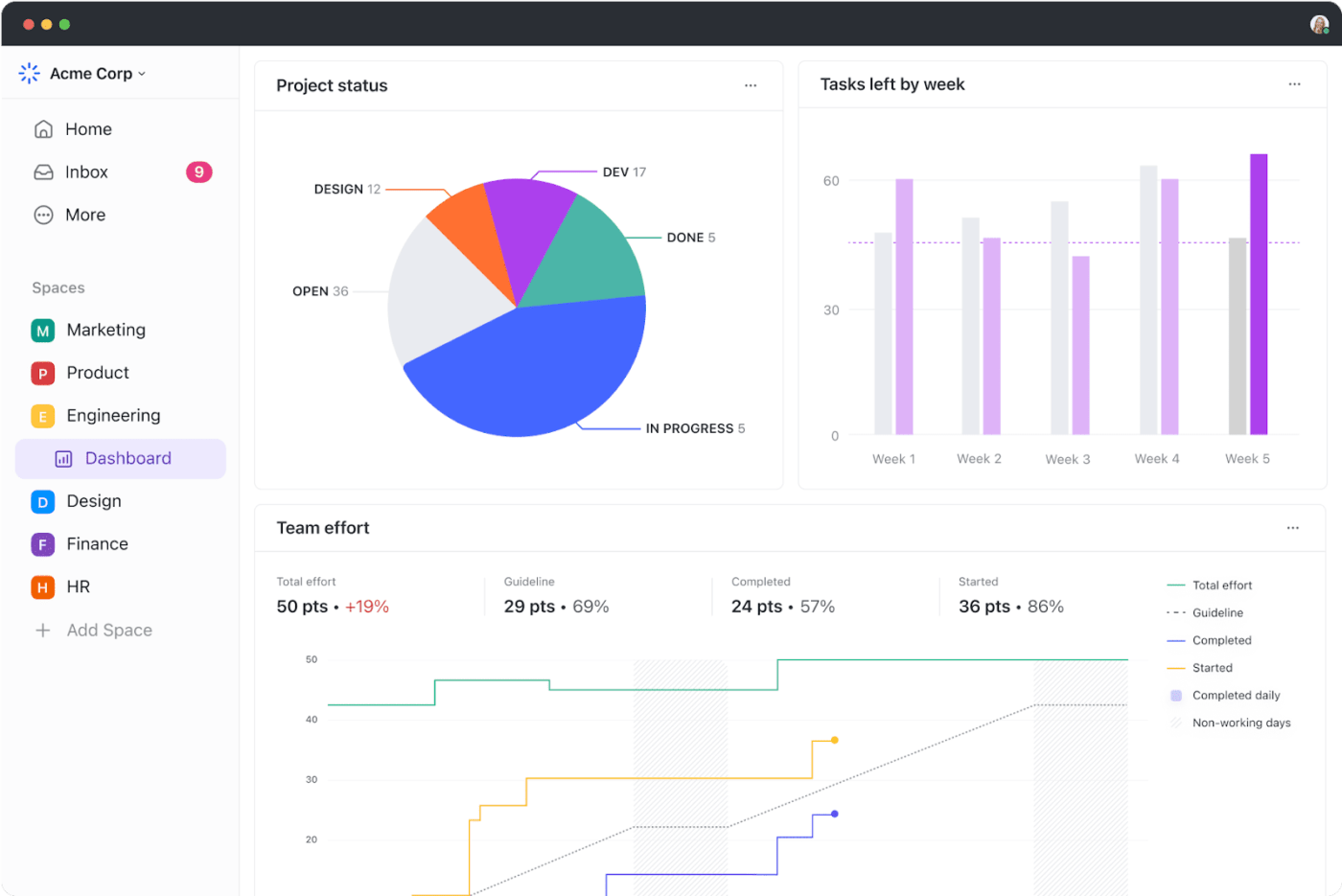
To apply this principle effectively, ClickUp Dashboards provide a visual overview of tasks, projects, and their respective outputs. By analyzing the data presented, you can quickly pinpoint which tasks are driving results and which ones are consuming time without delivering significant value.
This insight allows for a more efficient allocation of time and resources, ensuring prioritization of the right tasks that align with goals.
Hack 6: Eat that frog!
In productivity terms, this means tackling your hardest or most dreaded task first. Doing this removes the biggest obstacle early, allowing the rest of your day to feel more manageable and productive.
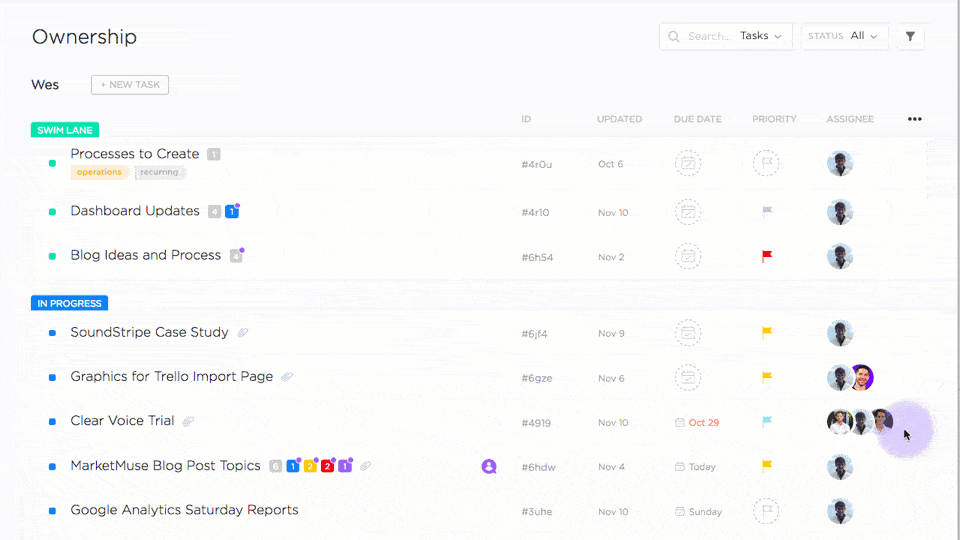
Use ClickUp Task Priorities to identify your frog. When planning your day, assign priority levels to each task, marking the most challenging or important one as ‘Urgent’ or ‘High.’ This way, it’s easy to see which task needs your attention first.
Once your frog is marked, start your day by focusing on that task. This method helps you build momentum, and with ClickUp’s visual priority indicators, you’ll never lose track of what matters most.
Hack 7: Batch similar tasks—and get them all done together
Group similar tasks, such as creating reports on different projects or making phone calls, and address them one after another.
🧠 Fun Fact: Task batching works because it minimizes context switching, which can drain your mental energy and reduce focus. By grouping similar tasks, you stay in the same cognitive “zone,” boosting efficiency and productivity.
ClickUp’s Subtasks allow me to break down large projects (e.g., “answer all emails”) into smaller, related tasks that I can tackle in one go. Each subtask can have its assignees, deadlines, priorities, and dependencies.
Hack 8: Take a shot at the 1-3-5 rule
The 1-3-5 rule is a simple method for staying productive without feeling overwhelmed. Aim to accomplish one big, three medium, and five small daily tasks.
For a marketing manager, the 1-3-5 rule could look like this:
- One big task: Develop the strategy for next quarter’s product launch
- Three medium tasks: Review ad copy, analyze campaign performance, and approve social media posts
- Five small tasks: Reply to emails, schedule a team meeting, check on a project update, proofread a blog post, and finalize a brief
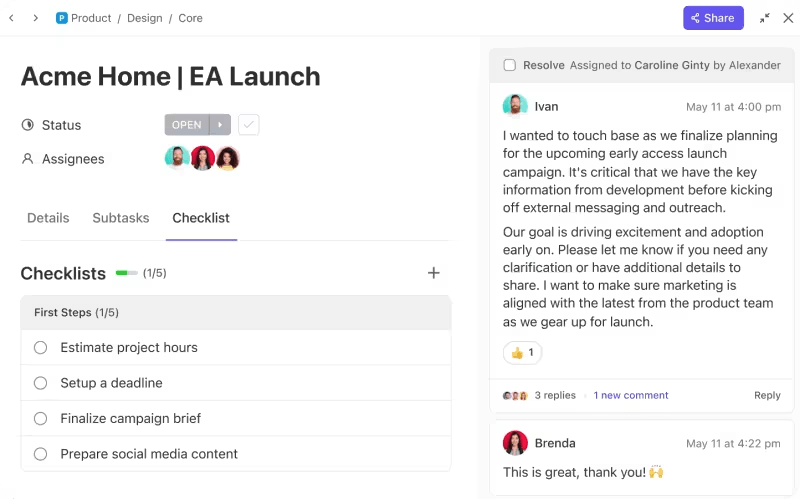
ClickUp Tasks can help you set deadlines, attach files, and track progress, making task management seamless.
Here’s how I use ClickUp Tasks for implementing the 1-3-5 rule:
Step 1: Create tasks
I add tasks to my ClickUp workspace, categorizing them into the 1-3-5 framework.
Step 2: Set deadlines
Next, I assign specific deadlines to each task, ensuring time-bound accountability.
Step 3: Add task descriptions
I provide clear and concise descriptions for each task, outlining the required actions.
Step 4: Attach relevant files
If there are documents, reports, or links related to the tasks, I attach them directly to each task. This way, everything is easily accessible, and the context remains in one place.
Step 5: Organize ClickUp Views
I use ClickUp’s List or Board Views to organize my tasks visually. This helps me prioritize and track my progress effectively.
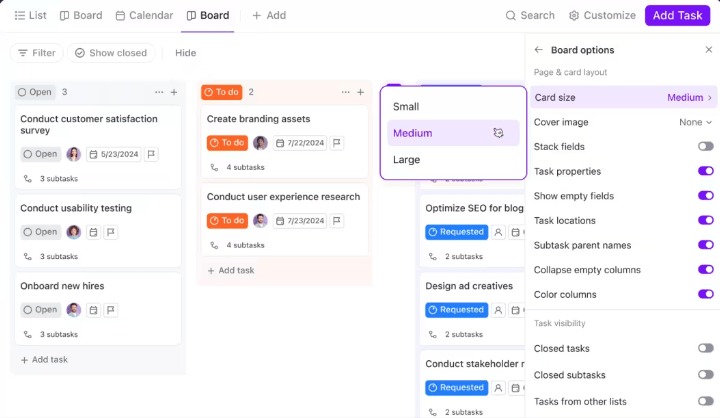
Hack 9: Use templates for repetitive tasks
Why reinvent the wheel? ClickUp offers a variety of templates to standardize recurring tasks, boost your productivity, and simplify your daily productivity tracking.
For example, ClickUp’s Personal Productivity Report Template can help you measure and track your progress on any task or project. Use it to track the time spent on each task, identify areas of improvement, and create personalized productivity reports.
This template is meant for beginners, so it’s a quick and easy way to start. Once you’ve identified repetitive tasks, you can decide how best to deal with them.
Hack 10: Delegate wisely
Effective delegation is a key factor that affects productivity.
Did you know you can reclaim up to 20% of your workday by identifying unimportant tasks and delegating them to others?
But how?
ClickUp offers several features that can significantly improve delegation. Two particularly useful features are ClickUp Chat and ClickUp Multiple Assignees.

With ClickUp Chat, you can have discussions directly linked to specific tasks or projects without needing two separate communication and project management tools. This means when you’re chatting about a task, everyone knows exactly what you’re referring to, which cuts down on confusion and keeps everything organized.
If someone mentions an action item in a conversation, you can quickly convert that message into a task with just a click. As a result, important points don’t get lost in the chat, and it’s super easy to assign responsibilities right then and there.

The chat lets you track who’s doing what through @mentions and FollowUps. You can see who’s available and manage workloads effectively, ensuring tasks are delegated to the right people without overwhelming anyone.
In contrast, multiple assignees enable you to assign a single task to more than one person, encouraging teamwork and shared responsibility. Multiple team members can collaborate on the same task, leveraging different skill sets.
Hack 11: Automate everything you can!
Repetitive tasks can be time-consuming. ClickUp Automations allows you to automate recurring tasks, such as sending reminders or updating statuses.
You can also leverage ClickUp Brain to improve your productivity without leaving your workspace.
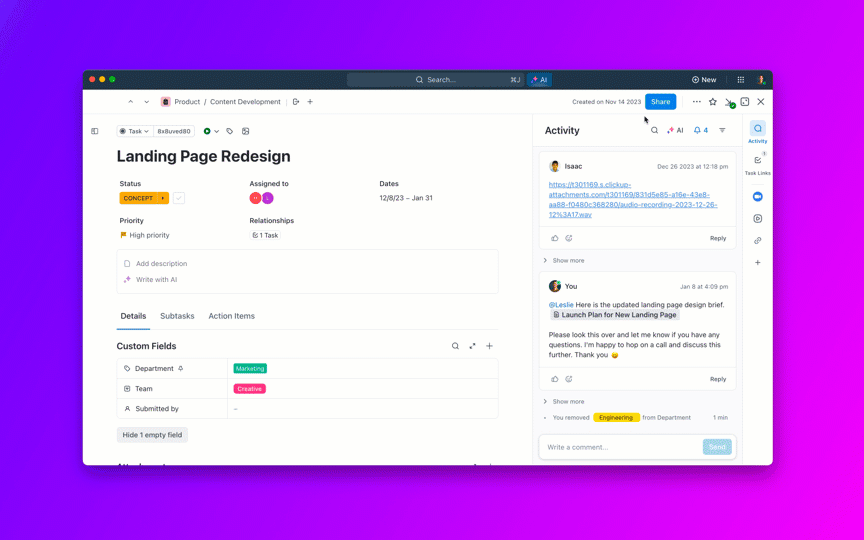
Unlike other AI tools that need you to input context manually, ClickUp Brain is integrated into your ClickUp workspace. It scans your tasks and projects to provide specific recommendations.
This lets you create smart connections between tasks, workflows, and information across your workspace.
Here are a few ways ClickUp Brain has helped me:
- If I’m brainstorming in a document and note down ‘publish the blog next Tuesday,’ ClickUp Brain can auto-generate a task for follow-up
- ClickUp Brain can predict the next steps in my workflow based on previous task behavior and automatically update task statuses as certain conditions are met, like task dependencies or milestones
- ClickUp Brain can analyze task dependencies and workload to automatically suggest prioritization, ensuring the most critical tasks are done first. It can suggest which tasks to focus on based on deadlines or dependencies, helping me stay productive
By integrating ClickUp Brain into your workflows, you can automate many manual processes, speed up work, and ensure your team stays focused on the high-priority items that matter most.
Hack 12: Conduct time audits
A time audit involves tracking how you spend every minute of your day. Here’s how it helps:
- Identifies time wasters like excessive meetings, social media distractions, or inefficient task-switching
- Improves time management by giving you a clearer understanding of how long specific activities take
- Increases focus and prioritization, leading to more intentional work on tasks that contribute to your goals
- Boosts accountability; knowing that you’re tracking every minute can motivate you to stick to productive habits
💡Pro Tip: Use ClickUp’s Project Time Tracking feature to monitor how long tasks are taking and adjust your schedule for maximum efficiency.
Hack 13: Transform your environment
Sometimes, all you need is a change of scene. Altering your surroundings introduces fresh sensory stimuli, disrupting habitual thought patterns. This phenomenon, known as the “Incubation Effect,” allows the brain to form new connections and explore alternative solutions.
Sprucing up your office space also enhances your mood and is a stress-buster.
💡Pro Tip: Set up a well-designed, clean, and clutter-free workspace. Work near natural light; exposure to sunlight has multiple health benefits and acts as a natural energy booster.
Hack 14: Adopt the Ivy Lee method
The Ivy Lee method forces you to prioritize, sequence, and single-task. Here’s how it works:
- Before finishing your workday, write down the six most important tasks in your to-do list for the next day
- Prioritize those six tasks based on their importance
- The next day, concentrate on those tasks in the order you’ve decided on
These simple steps can work wonders.
📗 Book Recommendations
Interested in exploring the Ivy Lee method further? Here are some suggestions on what to read:
- The Ivy Lee Method: The Daily Routine Experts Recommend for Peak Productivity by Sikandar Sami
- Free to Focus by Michael Hyatt
- The ONE Thing by Gary W. Keller and Jay Papasan
Hack 15: Use a digital notepad for brain dumps
Sometimes, you just need to get ideas out of your head and fleshed out onto paper. A brain dump can be considered one of the most powerful mental health tools.
Try ClickUp Notepad to jot down your thoughts on the go.
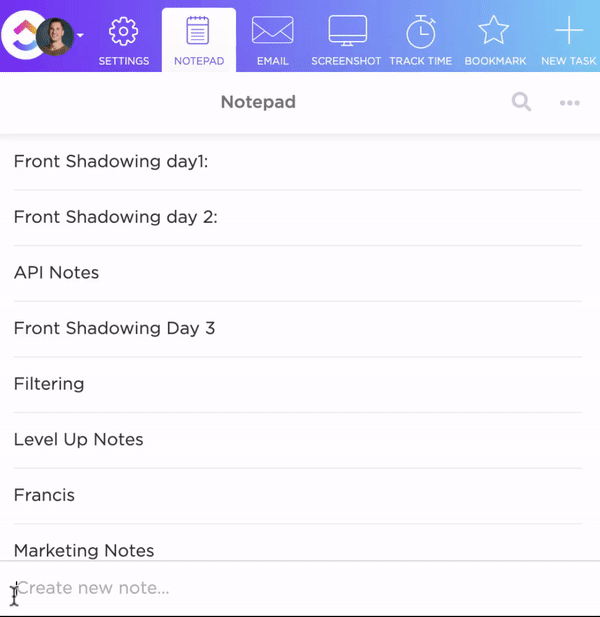
You can later convert these notes into trackable tasks to ensure your ideas are implemented. Moreover, the multi-device compatibility of the platform makes it easy to stay connected to all your notes from anywhere.
Hack 16: Say ‘No’ more often
Being productive doesn’t mean doing everything, everywhere, all at once.
Say no to tasks that don’t align with your goals. Your future self will thank you!
Saying “no” to inessential tasks helps you maintain focus on high-impact projects. Ultimately, this clarity leads to greater efficiency and satisfaction in achieving your objectives.
💡Pro Tip: How to Say No Gracefully
- Be Polite but firm: “Thanks for thinking of me, but I can’t take this on right now.”
- Offer an alternative: “I’m unable to help, but have you tried [another resource/person]?”
- Set boundaries: “I need to focus on my priorities, so I’ll have to decline.”
Hack 17: Schedule breaks
Scheduling regular breaks can prevent burnout and maintain high levels of productivity. They restore focus, reduce mental fatigue, and improve decision-making by giving your brain time to rest. They also boost creativity by allowing your subconscious to process information and generate fresh ideas.
Physically, breaks help prevent strain from prolonged sitting or screen time, keeping you energized and productive throughout the day.
One way to do this is by using ClickUp’s Time Blocking feature to ensure you’re setting aside time to recharge.
💡Pro Tips:
- Begin by creating a dedicated task in ClickUp specifically for your breaks. You can label it something like ‘Morning Break,’ ‘Lunch Break,’ or ‘Afternoon Stretch’
- Assign an appropriate time estimate for each break task. For instance, you might schedule 15 minutes for a short break or 30-60 minutes for lunch
- Drag and drop your break tasks into specific time slots in ClickUp’s Calendar View. You can block time for breaks around your work tasks to make sure your schedule reflects a healthy balance of focused work and relaxation
- Set these break tasks as recurring ones to make them a consistent routine. For example, schedule a 10-minute break every two hours or a 30-minute lunch every day
- Set notifications or reminders to alert you when it’s time for a break. These reminders can gently nudge you to pause work, get up, stretch, or relax
This time-blocking feature allows you to organize your workday to support efficiency and personal well-being, leading to better long-term outcomes.
Hack 18: Set SMART goals
SMART (Specific, Measurable, Achievable, Relevant, Time-bound) goals help you keep your eye on the ball. They provide clear direction, making it easier to stay focused and motivated. Breaking down large tasks into smaller, actionable steps prevents overwhelm and increases accountability.
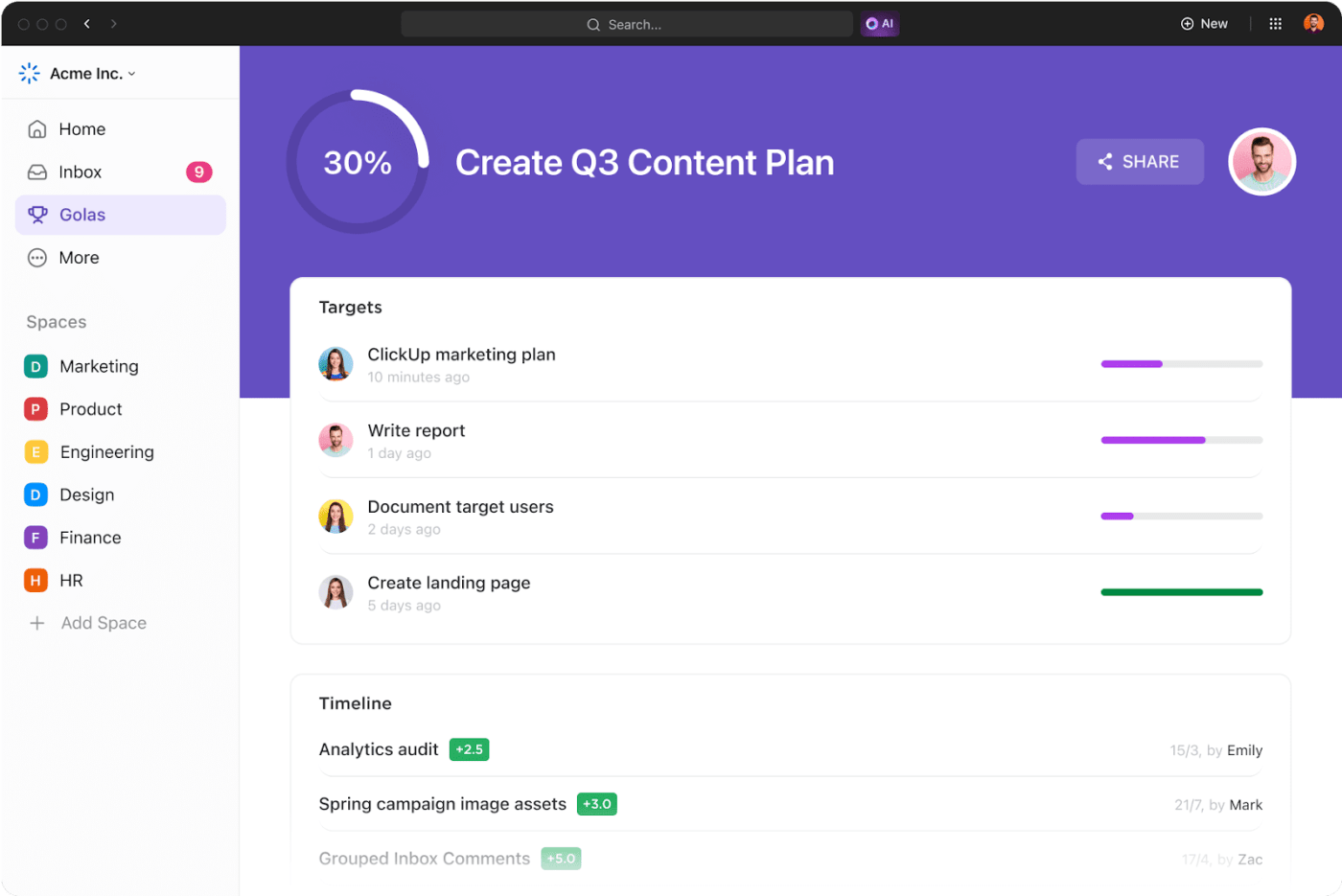
Use ClickUp Goals to track and manage your objectives effectively. Here’s how I use this feature to increase my productivity:
- Create a goal and write a detailed description that specifies what I want to achieve
- Add checklists to break down the goal into specific tasks
- Assign measurable targets to my goals (e.g., ‘Post two blogs by the week’s end). I use the ‘Target’ section to define what success looks like
- Assign a due date to each goal and use milestones to set significant checkpoints throughout the goal duration
- Set reminders in ClickUp to review goals periodically and assess their relevance
Hack 19: Reflect and adjust
At the end of each week, take a moment to review progress and see where adjustments are needed.
ClickUp Dashboards and progress-tracking features offer real-time insights into your performance, making it easier to course-correct when needed.
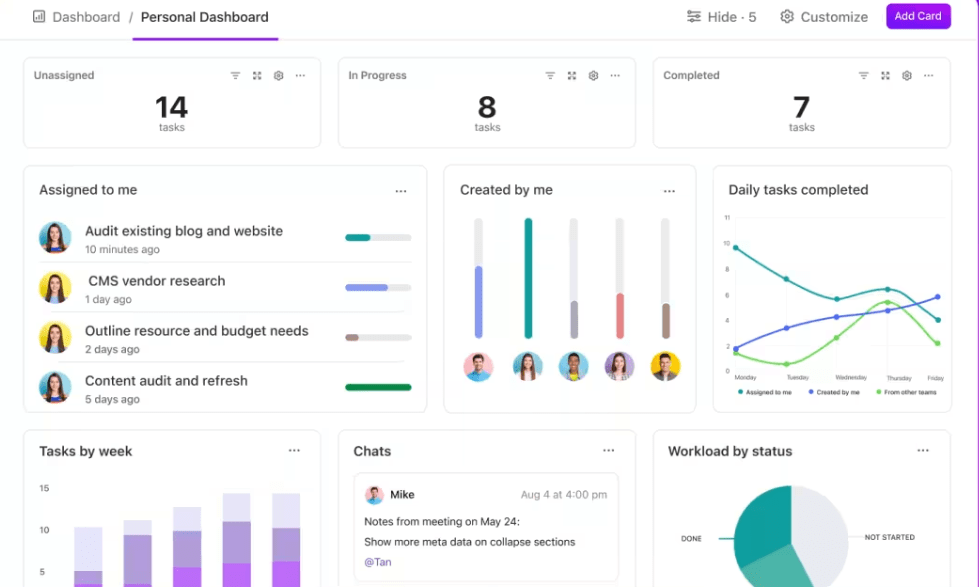
Dashboards give you a bird’s-eye view of your week, allowing you to fine-tune your approach and course-correct when necessary.
Hack 20: Use reminders
Reminders can be powerful tools. They help avoid the stress of last-minute rushes or overlooked details.
ClickUp Reminders can help you stay organized by gently nudging you when something requires attention. These reminders ensure nothing is inadvertently overlooked, whether a small daily task or a critical deadline.
Digital Tools and Apps for Productivity
Productivity tools are now automating routine tasks, analyzing data, and generating insights faster. From simple email filters to sophisticated virtual assistants like Siri, AI is seamlessly integrated into our daily lives.
Choosing the right tool can supercharge your task, document, and knowledge management, boosting your productivity quickly.
ClickUp
Consider ClickUp. It’s the everything app for work, with all of the above capabilities built-in and enhanced by AI to allow individuals and teams to achieve more in less time.
With a wide range of features, such as ClickUp Brain, ClickUp provides a centralized hub for all your work.
In addition to managing tasks, ClickUp Brain helps you:
- Get real-time project summaries and updates without opening individual tasks, enhancing overall efficiency via AI StandUps

- Gather contextual answers and insights, connecting various elements of your workspace seamlessly
- Create tailored, on-brand content in ClickUp Docs—from social media captions and quick email replies to full-fledged blog posts and project reports

ClickUp also has many prebuilt productivity templates (such as the ClickUp Personal Productivity Template) that help you stay organized.
The ClickUp Personal Productivity Template helps me categorize tasks by priority, allowing me to focus on what’s most important while visualizing the progress of all tasks. I can also customize the template to set SMART goals, create a schedule, remind myself to take breaks, and even accelerate my progress with collaboration features.
Here’s what the template helps me do:
- Categorize tasks by urgency and importance
- Track tasks and get a clear overview of where I stand daily
- Align tasks with specific, measurable, achievable goals
- Set break reminders to prevent burnout and maintain a healthy work pace
- Share tasks and progress with my team to speed up workflow and maintain accountability
The best part? ClickUp integrates with 1000+ apps, including those you use daily, such as Google Workspace, Slack, HubSpot, Outlook, and more!
Tips for Sustained Productivity
Once you find a hack that works, consistency is important. These tips will help you stay on track:
1. Building productive habits
Developing consistent habits is essential to maintaining long-term productivity. Start by integrating a few of these hacks into your daily routine.
For instance, if time blocking has proven effective, schedule time blocks for your most important daily tasks. ClickUp’s Recurring Tasks feature is a powerful tool for automating reminders for these key activities.
2. Managing distractions
Distractions are unavoidable in a fast-paced organization. However, you can take proactive steps to mitigate their impact.
For example, when working with ClickUp Docs, ClickUp’s Focus Mode allows you to immerse yourself in your writing without the noise of notifications or interruptions. Combine this with ClickUp Reminders for critical deadlines and tasks, and you’ll find it easier to maintain focus.
3. Setting realistic goals
Setting ambitious goals is essential, but they must be grounded in reality to be effective. Use ClickUp Goals to define clear, actionable objectives that align with your broader business strategy.
4. Tracking progress and adjusting strategies
Regularly monitoring your performance and measuring your productivity can help you stay on track. With ClickUp’s Dashboards, you can visualize your output and identify trends over time. This data-driven approach empowers you to adjust your strategies proactively.
For example, if you notice a dip in productivity during certain hours, you can schedule your easiest, most mundane tasks for those times. Similarly, try shifting your most demanding tasks to times when you’re naturally more alert.
Staying Productive Consistently with ClickUp
Heightened productivity requires minimal distractions, seamless collaboration, and choosing tasks that bring you closer to your larger goals. Productivity hacks are not just about getting things done—they’re about creating a rhythm that works for you and your team.
Turn the daily grind into a more fluid and enjoyable experience. Keep discovering meaningful ways to reclaim your time and boost team productivity.
Finally, one last productivity hack.
When all else fails, a dash of humor may be just what you need. It raises team spirit and motivates people to take up challenges that may seem impossible. The easiest way to get started?





